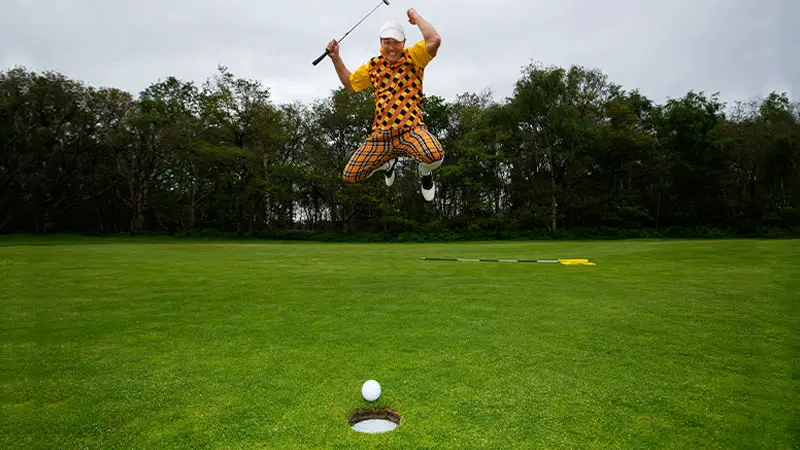Golf is a sport rich with its own unique terminology, and one term that resonates deeply with enthusiasts is “birdie.”
In golfing parlance, a birdie signifies a noteworthy achievement—completing a hole with a stroke count one under par.
This accomplishment not only showcases a player’s skill and precision but also adds an extra layer of excitement to the game.
Understanding the concept of a birdie enhances one’s appreciation for golf’s intricacies. Whether it’s a net birdie, which factors in a player’s handicap, or a gross birdie, representing the raw score, each type carries its own significance.
This article dives into the origins of the term, its relationship to par, and the thrill of scoring this coveted mark on the course.
Understanding Birdie in Golf
Definition of a Birdie
A birdie in golf signifies completing a hole with one stroke fewer than par. On a par-4 hole, a golfer records a birdie by finishing in three strokes.
This term represents a notable achievement, showcasing a player’s precision and skill. Birdies stem from the idea of “bird” being slang for something excellent in the early 20th century.
How a Birdie Fits in the Golf Scoring System?
In golf, the scoring system is designed to compare the number of strokes a player takes to complete each hole against a standardized expectation known as “par.” Here’s a breakdown of how birdies fit into this system:
- Par Definition:
- Par is the predetermined number of strokes that an expert golfer is expected to need to complete a hole. Par values typically range from 3 to 5 strokes per hole, depending on the hole’s length and difficulty.
- For a standard 18-hole golf course, the total par might range from 70 to 72 strokes.
- Scoring Terms:
- Eagle: Completing a hole in two strokes less than par (e.g., 3 strokes on a par-5 hole).
- Birdie: Completing a hole in one stroke less than par (e.g., 4 strokes on a par-5 hole).
- Par: Completing a hole in the expected number of strokes.
- Bogey: Completing a hole in one stroke more than par (e.g., 6 strokes on a par-5 hole).
- Double Bogey: Completing a hole in two strokes more than par.
- Birdie in Detail:
- A birdie is scored when a golfer completes a hole in one stroke fewer than the par for that hole. For example:
- On a par-3 hole, a birdie is achieved by completing the hole in 2 strokes.
- On a par-4 hole, a birdie is achieved by completing the hole in 3 strokes.
- On a par-5 hole, a birdie is achieved by completing the hole in 4 strokes.
- Birdies are considered a significant achievement because they indicate that the golfer performed better than the expected standard for that hole.
- A birdie is scored when a golfer completes a hole in one stroke fewer than the par for that hole. For example:
- Impact on Total Score:
- In a round of golf, the goal is to complete the course with the fewest strokes possible. Each birdie reduces the total stroke count by one, improving the player’s score relative to par.
- For example, if a player achieves a birdie on four different holes in an 18-hole course with a total par of 72, their final score would be 68 (72 – 4).
- Comparison of Performance:
- By using par as a benchmark, birdies allow for a standardized comparison of performance across different holes and different players.
- Achieving birdies consistently indicates a high level of skill and proficiency.
The Origin of the Term ‘Birdie’
The term “birdie” in golf, which means a score one stroke below par, originated in the early 20th century in American golfing circles.
It derives from American slang, where “bird” meant something particularly good. The first known use occurred at the Atlantic City Country Club in New Jersey in 1903, when golfer Abner Smith described an impressive shot as a “bird of a shot,” which evolved into “birdie.”
The earliest documented reference is in HB Martin’s “Fifty Years of American Golf,” recounting a 1899 match at the same club. The term quickly spread, becoming standard in golf terminology to denote exceptional performance.
How to Score a Birdie?
Key Techniques and Strategies
Achieving a birdie requires precision and strategy. Here are several effective techniques to increase the chances of scoring a birdie:
- Targeted Shots: Aim for long, straight, and precise shots. The more exact the swings, the better the odds of landing the ball closer to the hole.
- Club Selection: Use golf clubs that enhance striking power while maintaining balance and control. A well-chosen club can significantly aid in executing refined shots.
- Green Focus: Rather than targeting the pin directly, aim for the middle of the green. This approach provides a better margin for error and increases the likelihood of setting up a manageable putt.
- Practice: Regular practice is essential. The more time spent fine-tuning skills, the better the performance under actual playing conditions.
- Mental State: A clear mind and relaxed body contribute to better performance. High stress and negative thoughts can adversely affect the shots, so stay composed and focused.
Professionals average five birdies per round because of consistent application of these techniques. While achieving these results might be challenging for amateurs, diligent practice makes improvement possible.
Differences Between Amateur and Professional Play
Scoring a birdie differs significantly between amateur and professional golfers. These differences are influenced by skill level, experience, and course management.
- Skill Level: Professionals possess advanced skills honed through years of practice. Their swings are more refined, and they make fewer mistakes. Amateurs lack the same level of precision and control.
- Consistency: Professionals maintain higher consistency in their play. They can replicate successful shots more reliably, whereas amateurs show more variability in their performance.
- Course Management: Professionals exhibit superior course management. They understand golf course intricacies better and make strategic decisions that enhance their chances of scoring a birdie. Amateurs often miss these subtle aspects of play.
- Pressure Handling: Professionals manage pressure effectively. They perform well even under high-stress conditions. Amateurs might struggle with maintaining composure, affecting their overall game.
Understanding these differences helps amateurs identify areas for improvement. Even though scoring a birdie is a rare achievement for an average player, adopting professional techniques can significantly enhance their chances.
Comparison With Other Golf Scoring Terms
Par vs. Birdie
Par refers to the standard score that an expert golfer is expected to achieve on a hole. It’s determined based on the hole’s length and difficulty, typically ranging from three to five strokes.
A birdie, on the other hand, signifies scoring one stroke under par on a hole, demonstrating exceptional play. For example, completing a par four hole with three strokes counts as a birdie, rewarding the golfer’s precision and skill.
Birdie vs. Eagle
An eagle represents an even more impressive feat than a birdie. While a birdie is one stroke under par, an eagle is two strokes under par.
Achieving an eagle usually requires either a perfectly executed long shot or two well-coordinated shots on a par five, for instance, reaching the green in two strokes and sinking the putt in one. The difficulty level rises significantly from birdie to eagle due to the increased precision needed.
The Significance of Albatross and Condor
An albatross, also known as a double eagle in American terminology, is three strokes under par. This rare accomplishment often involves landing the ball in the hole directly from a long-distance shot, such as on a par five hole in just two strokes.
An even rarer term is the condor, which means scoring four strokes under par, typically on a par five hole. These terms are part of the bird-themed lexicon, symbolizing extraordinary skill and luck in golf.
Below is a summary table highlighting the differences between various golf scoring terms:
| Term | Strokes Under Par | Example (Par 4 Hole) |
|---|---|---|
| Par | 0 | 4 strokes |
| Birdie | 1 | 3 strokes |
| Eagle | 2 | 2 strokes |
| Albatross | 3 | 1 stroke |
| Condor | 4 | Not achievable on par 4 |
Understanding these terms helps golfers appreciate the skill involved in achieving each score, from the commonly sought birdie to the almost mythical condor.
Strategically inserting keywords related to “birdie in golf” throughout enhances SEO performance while providing authoritative content for avid readers and golf enthusiasts.
Frequently Asked Questions
How often do golf professionals score birdies?
Golf professionals typically average around five birdies per round. Their consistent application of refined techniques and strategies allows them to achieve these frequent sub-par scores.
How can amateurs improve their chances of scoring a birdie?
Amateurs can improve by focusing on precision, practicing consistently, choosing the right clubs, managing the course intelligently, and developing a strong mental approach. These aspects enhance overall game performance and birdie opportunities.
How does a birdie compare to other golf scores like an eagle or an albatross?
A birdie is one stroke under par, an eagle is two strokes under par, and an albatross (or double eagle) is three strokes under par. Each lower score indicates a higher level of skill and precision in the game.
What is the origin of the term “birdie” in golf?
The term “birdie” originated in American golfing circles in the early 20th century. It likely comes from the slang term “bird,” meaning something excellent, representing a commendable achievement in golf.
Conclusion
Achieving a birdie in golf is a testament to a player’s skill and dedication. By mastering precision, club selection, and mental focus, golfers can significantly improve their chances of scoring a birdie.
Understanding the nuances between different scoring terms like par, eagle, and albatross further deepens one’s appreciation for the sport.
Whether you’re an amateur aiming to elevate your game or a professional striving for consistency, the pursuit of a birdie remains a rewarding challenge that embodies the essence of golfing excellence.
Regular practice, studying course layouts, and learning from seasoned players can further enhance one’s ability to secure birdies. Each successful birdie not only boosts confidence but also sharpens gameplay.








Colin McCarthy